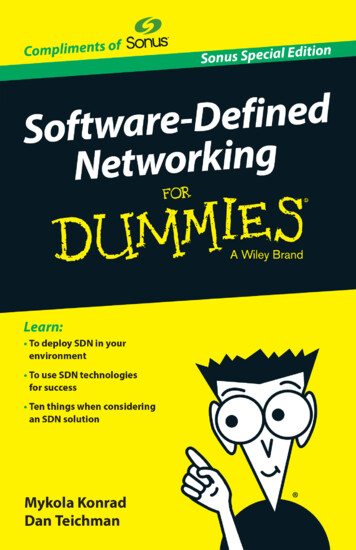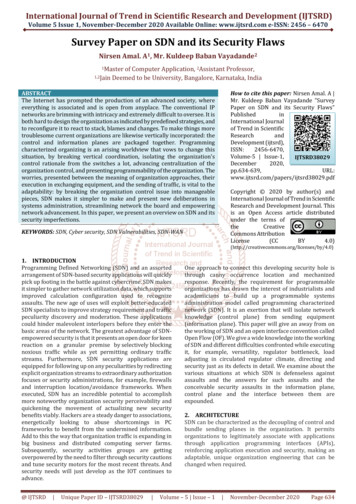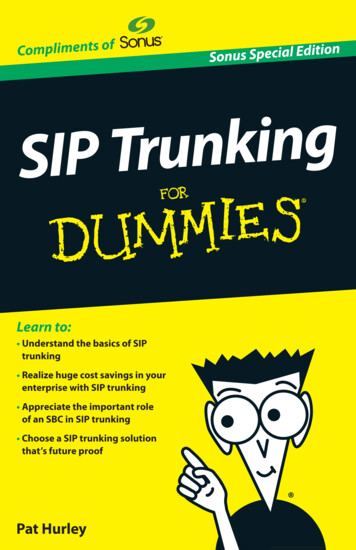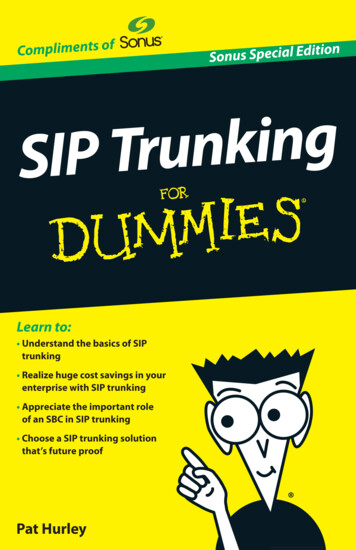
Transcription
These materials are 2016 John Wiley & Sons, Inc. Any dissemination, distribution, or unauthorized use is strictly prohibited.
Software‐DefinedNetworkingSonus Special Editionby Mykola Konrad andDan Teichmanwith Brian UnderdahlThese materials are 2016 John Wiley & Sons, Inc. Any dissemination, distribution, or unauthorized use is strictly prohibited.
Software-Defined Networking For Dummies , Sonus Special EditionPublished byJohn Wiley & Sons, Inc.111 River St.Hoboken, NJ 07030‐5774www.wiley.comCopyright 2016 by John Wiley & Sons, Inc.No part of this publication may be reproduced, stored in a retrieval system or transmitted in anyform or by any means, electronic, mechanical, photocopying, recording, scanning or otherwise,except as permitted under Sections 107 or 108 of the 1976 United States Copyright Act, without theprior written permission of the Publisher. Requests to the Publisher for permission should beaddressed to the Permissions Department, John Wiley & Sons, Inc., 111 River Street, Hoboken, NJ07030, (201) 748‐6011, fax (201) 748‐6008, or online at http://www.wiley.com/go/permissions.Trademarks: Wiley, For Dummies, the Dummies Man logo, The Dummies Way, Dummies.com,Making Everything Easier, and related trade dress are trademarks or registered trademarks ofJohn Wiley & Sons, Inc., and/or its affiliates in the United States and other countries, and may notbe used without written permission. Sonus and the Sonus logo are registered trademarks of Sonus.All other trademarks are the property of their respective owners. John Wiley & Sons, Inc., is notassociated with any product or vendor mentioned in this book.LIMIT OF LIABILITY/DISCLAIMER OF WARRANTY: THE PUBLISHER AND THE AUTHOR MAKENO REPRESENTATIONS OR WARRANTIES WITH RESPECT TO THE ACCURACY ORCOMPLETENESS OF THE CONTENTS OF THIS WORK AND SPECIFICALLY DISCLAIM ALLWARRANTIES, INCLUDING WITHOUT LIMITATION WARRANTIES OF FITNESS FOR APARTICULAR PURPOSE. NO WARRANTY MAY BE CREATED OR EXTENDED BY SALES ORPROMOTIONAL MATERIALS. THE ADVICE AND STRATEGIES CONTAINED HEREIN MAY NOT BESUITABLE FOR EVERY SITUATION. THIS WORK IS SOLD WITH THE UNDERSTANDING THAT THEPUBLISHER IS NOT ENGAGED IN RENDERING LEGAL, ACCOUNTING, OR OTHER PROFESSIONALSERVICES. IF PROFESSIONAL ASSISTANCE IS REQUIRED, THE SERVICES OF A COMPETENTPROFESSIONAL PERSON SHOULD BE SOUGHT. NEITHER THE PUBLISHER NOR THE AUTHORSHALL BE LIABLE FOR DAMAGES ARISING HEREFROM. THE FACT THAT AN ORGANIZATIONOR WEBSITE IS REFERRED TO IN THIS WORK AS A CITATION AND/OR A POTENTIAL SOURCEOF FURTHER INFORMATION DOES NOT MEAN THAT THE AUTHOR OR THE PUBLISHERENDORSES THE INFORMATION THE ORGANIZATION OR WEBSITE MAY PROVIDE ORRECOMMENDATIONS IT MAY MAKE. FURTHER, READERS SHOULD BE AWARE THAT INTERNETWEBSITES LISTED IN THIS WORK MAY HAVE CHANGED OR DISAPPEARED BETWEEN WHENTHIS WORK WAS WRITTEN AND WHEN IT IS READ.For general information on our other products and services, or how to create a custom For Dummiesbook for your business or organization, please contact our Business Development Department in theU.S. at 877‐409‐4177, contact info@dummies.biz, or visit www.wiley.com/go/custompub. Forinformation about licensing the For Dummies brand for products or services, contactBrandedRights&Licenses@Wiley.com.ISBN: 978‐1‐119‐23614‐6 (pbk); ISBN: 978‐1‐119‐23615‐3 (ebk)Manufactured in the United States of America10 9 8 7 6 5 4 3 2 1Publisher’s AcknowledgmentsSome of the people who helped bring this book to market include the following:Project Editor: Carrie A. JohnsonEditorial Manager: Rev MengleAcquisitions Editor: Katie MohrBusiness Development Representative:Sue BlessingProduction Editor: Kumar ChellappanThese materials are 2016 John Wiley & Sons, Inc. Any dissemination, distribution, or unauthorized use is strictly prohibited.
Table of ContentsIntroduction . . . . . . . . . . . . . . . . . . . . . . . . . . . . . . . . . . . . . . 1About This Book. 1Icons Used in This Book. 2Chapter 1: Introducing SDN. . . . . . . . . . . . . . . . . . . . . . . . . 5Getting to Know SDN. 5Network intelligence. 6Shifting priorities. 6Network resource management. 7Benefits. 8Understanding Control versus Data Plane. 9Looking at Underlay versus Overlay. 10Chapter 2: Applying SDN to the CloudExchange Network. . . . . . . . . . . . . . . . . . . . . . . . . . . . . 11Understanding What’s Really Needed to Succeed. 12Simplifying and Automating the Provisioning Process. 13Discovering Network Topology. 13Translating Business Policies into DataFlow Requirements. 14Dynamically Computing Paths. 15Enforcing Policy, Flow Management, and Metering. 15Managing Multi-Tenants. 17Chapter 3: Looking at an Enterprise Use CaseExample and Its Benefits. . . . . . . . . . . . . . . . . . . . . . . . 19Addressing the Problems. 19Optimizing Inter-Office Connectivity. 21Providing Business Continuity and Disaster Recovery. 22Chapter 4: Seeing a Service Provider Use CaseExample and Its Benefits. . . . . . . . . . . . . . . . . . . . . . . . 25Optimizing Data Center Interconnect. 26Providing Better Management for Multi-tenantMetro Ethernet. 28These materials are 2016 John Wiley & Sons, Inc. Any dissemination, distribution, or unauthorized use is strictly prohibited.
ivSoftware-Defined Networking For Dummies, Sonus Special Edition Chapter 5: SDN Deployment . . . . . . . . . . . . . . . . . . . . . . . 31Setting Migration Strategy. 31Adopting the Cloud. 31Implementing the right migration strategy. 32Taking enough time. 33Looking for Vendors That Can Scale. 34Chapter 6: Ten Things You Need to KnowWhen Considering an SDN Solution. . . . . . . . . . . . . . 37Translating Application/Business Policies. 37Understanding Why SDN in Data Centers Is Successful. 38Seeing Why the Cloud Exchange Network Is Nowon a Critical Path. 38Applying SDN to the Cloud Exchange Network Domain. 39Applying SDN in SP Networks. 39Using SDN in Enterprise Networks. 39Automating Network Resource Configuration. 40Simplifying Network Resource Configuration. 40Ensuring Application Performance. 41Managing Multi-tenants. 41These materials are 2016 John Wiley & Sons, Inc. Any dissemination, distribution, or unauthorized use is strictly prohibited.
IntroductionService providers are looking to monetize their data networks and data centers in a very competitive market.Enterprises are moving more of their applications and associated data to the Cloud. For enterprises moving theirapplication infrastructure from in‐house to the Cloud, the process can be complicated. To succeed, they have to dotheir research, select which applications to migrate to theCloud, determine a preferred Cloud option, identify suppliers,propose a project plan, and commit to the implementation.That’s a lot to tackle, yet it still doesn’t complete the job,because now applications and data reside in a remote datacenter. They also need to include an assessment of their widearea network requirements and determine the best solutionso that it, too, contributes to a successful Cloud migration.Software‐defined networking (SDN) presents a new way ofl ooking at how networking systems can be automated, efficient, and scalable. SDN is an opportunity for serviceproviders to provide their networks as a service (NaaS) toenterprise customers. For enterprise customers, SDN is away to lower costs by optimizing bandwidth and creatinghybrid WANs.About This BookSoftware‐Defined Networking For Dummies, Sonus SpecialEdition, shows you what you need to know about SDN asenterprises and service providers move toward the future ofCloud networking. You see what SDN is, how it works, andhow to choose the right Cloud network solution. SDN is atechnology — it allows networks to become adaptable to business needs. But just putting in an SDN controller isn’t enough;it’s more important to intelligently adapt the network, whichrequires a knowledge of application needs, network topologyThese materials are 2016 John Wiley & Sons, Inc. Any dissemination, distribution, or unauthorized use is strictly prohibited.
2Software-Defined Networking For Dummies, Sonus Special Edition across network layers 2 and 3, and intelligent network pathcomputation. This book provides some examples of the current state of the art in SDN and how your organization can useSDN technologies to be successful.For many people, SDN has come to mean IT infrastructureadaptation to support virtualized workloads. And what thishas led to is using SDN to just reimplement classic networkarchitectures. This is one definition of SDN and allows somecost efficiencies. But for service providers and enterprises,this narrow definition misses the point. The true value of SDNis in the intelligence that allows service providers to offer newservices and enterprises that offer Cloud‐based applicationsto their customers/employees with the quality and reliabilitythat is required in today’s competitive market.This book is broken down into six chapters: Chapter 1 provides the basics of what makes up SDN. Chapter 2 gives you a feel for how SDN is implemented ina real-world, complex environment. Chapter 3 provides some insight into how SDN can benefit the enterprise. Chapter 4 explains how an SDN‐based Network as aService can help service providers provide better serviceto customers. Chapter 5 gives you some tips about planning for SDN. Chapter 6 provides a handy resource of important information you’ll need to implement SDN successfully.Icons Used in This BookThis book uses the following icons to call your attention toinformation you may find helpful in particular ways.The information marked by this icon is important and therefore repeated for emphasis. This way, you can easily spotnoteworthy information when you refer to the book later.These materials are 2016 John Wiley & Sons, Inc. Any dissemination, distribution, or unauthorized use is strictly prohibited.
Introduction3This icon points out extra‐helpful information.This icon marks places where technical matters, such as SDNjargon and whatnot, are discussed. Sorry, it can’t be helped,but it’s intended to be helpful.Paragraphs marked with the Warning icon call attention tocommon pitfalls that you may encounter.These materials are 2016 John Wiley & Sons, Inc. Any dissemination, distribution, or unauthorized use is strictly prohibited.
4Software-Defined Networking For Dummies, Sonus Special Edition These materials are 2016 John Wiley & Sons, Inc. Any dissemination, distribution, or unauthorized use is strictly prohibited.
Chapter 1Introducing SDNIn This Chapter Getting to know what SDN is all about Separating control and data Considering underlay and overlayThere’s little doubt that networks are a vital part of today’senterprise computing environment. But as the importanceof networks has grown, so has the complexity of managingand maintaining the network. Software‐defined networking(SDN) represents a whole new way of looking at how networksare configured, controlled, and operated.This chapter provides an introduction to SDN and explainssome of the technology that’s involved. You see how SDNmakes managing a complex system much simpler and morereasonable.Getting to Know SDNIn the past, the enterprise or service provider answer to growing demand for data capacity and increasing bandwidth needswas to throw in a bunch of money in the form of additionalhardware capacity. That’s a costly approach, especially in theface of exponential growth in demand. Today’s business climate calls for something better.SDN provides a method for separating the actual physicalnetwork hardware from the processes used to manage howthe network functions and how data flows across the network.SDN enables you to administer your network more efficientlyThese materials are 2016 John Wiley & Sons, Inc. Any dissemination, distribution, or unauthorized use is strictly prohibited.
6Software-Defined Networking For Dummies, Sonus Special Edition because you can create policies (rules) that apply across thenetwork telling each device how to handle traffic and alsocontrolling access to enterprise resources. With an SDN solution, it’s no longer necessary to physically touch routers,switches, gateways, and such in order to change how each ofthem functions.Network intelligenceAn SDN divides the data plane from the network intelligence.So the key to an effective SDN implementation is not just theSDN controllers but the actual intelligence engine that controls the network. Key aspects of network intelligence are Network topology discovery: The ability for a controllerto effectively understand the existing network topology Policy rules: A set of rules that are based on businesspolicies that are key inputs to determine which routestraffic should follow Path computation: A real‐time engine that takes thepolicy rules and the network topology and determinesthe best possible path that packets should take to traverse a networkThis path computation intelligence is what makeschanges to the network based on the needs of a specificpacket or IP Flow.Your customers need to be able to simply specify applicationand business priorities and service level requirements. Besure that your SDN solution has the intelligence to be able totranslate this information into meaningful input that can perform path computation to select the optimal WAN path.Shifting prioritiesMost organizations are experiencing shifting priorities asthey move away from traditional client/server architecturetoward providing users with more flexibility. Instead of beingtied down to a workstation in the office, users are demandingThese materials are 2016 John Wiley & Sons, Inc. Any dissemination, distribution, or unauthorized use is strictly prohibited.
Chapter 1: Introducing SDN7access to corporate data through their laptops, tablets, andsmartphones.This demand for increased flexibility in accessing enterpriseresources has resulted in the need for new ways in definingand managing the networks. Certainly, there’s a greater needthan ever to protect corporate data by enforcing strong security policies. But, those policies can’t come at the expenseof ease of access for the users who have legitimate needs toaccess that data no matter where the user might be working.Network resource managementThe demands for increased flexibility and access have causednetworks to grow in size and become much more complex tomanage and maintain. The result has been that ever more ITresources are needed to handle processes such as provisioning, configuration, and remediation. These processes havetypically been cumbersome so growing your network meantthat someone had to touch and configure each and everydevice.The traditional way of provisioning and managing networkassets is no longer dynamic enough to keep up with the newdemands. You have to deal with competitive pressures thatforce you to be more efficient. You need to consider the following important requirements: Real‐time management: You must manage networkassets in real time based on business priorities.Accommodating changes in network resource requirements needs to be automated as much as possible. Application traffic prioritization: Traffic must be prioritized based on business priorities for different applications, both during both normal and non‐normal workingsituations. Bandwidth utilization: You need to dynamically allocateresources to maximize network utilization and to lowerthe cost of network ownership.These materials are 2016 John Wiley & Sons, Inc. Any dissemination, distribution, or unauthorized use is strictly prohibited.
8Software-Defined Networking For Dummies, Sonus Special Edition An SDN solution enables you to provision and manage yournetwork resources in real time and transforms your networkinto a strategic asset.BenefitsA good SDN solution offers a number of benefits for yourorganization. These range from cost savings through reducedtime spent on manual tasks to better utilization of existingresources. Here are a few of the benefits you’ll see: Automatic provisioning: Simplified provisioning usinga web‐based portal or API means that business policiesare automatically translated into WAN configuration, andprovisioning for network devices can use simple forwarding tables instead of complicated routing. Automationminimizes, and possibly eliminates the need for anymanual provisioning. Any changes in network topologyare automatically detected and an updated topology ismaintained so future path computations are optimized. Dynamic allocation: Bandwidth allocation to meet application requirements is managed on‐demand. The implementation of WAN changes based on business prioritiescan be handled quickly. Examples of these changesinclude time‐of‐day adjustments to bandwidth for anightly data replication program or ensuring a high priority for every 15-minute backup of critical billing records. Flexibility: An SDN provides responsiveness to accommodate changes in network topology or changes in network behavior. To resolve a fairly simple yet commonevent, such as where network congestion is degradingapplication performance, network resources need to bereallocated in real‐time (in milliseconds) to ensure trafficflows around network congestion points. Security: Identification of network devices is automatedand access to network devices is protected and limited. Ifa network device is unknown, no traffic is allowed to flowto/from it. If traffic originates with an unknown user orapplication, it is not allowed onto the network. Visibility: From the IT manager to the CIO, ensuring theexpected network behavior matches actual behavioris crucial, especially for business critical applications.These materials are 2016 John Wiley & Sons, Inc. Any dissemination, distribution, or unauthorized use is strictly prohibited.
Chapter 1: Introducing SDN9Having end‐to‐end monitoring and analytics of trafficflows and application statistics provides the visibilitythat is critical to decision making and ultimately forensuring the WAN is a strategic asset.Understanding Controlversus Data PlaneOne of the key elements in SDN is the concept of separatingthe control plane from the data plane. The control plane is thesystem that makes decisions about where network traffic issent and the data plane consists of the systems that actuallyforward the traffic to its destination.Different vendors often use their own terminology for variousSDN elements. For example, you may see the control planecalled the signaling plane and the data plane is sometimescalled the forwarding plane.Separating the two systems is important because this separation is what enables network functions to be automated. By separating the control plane from the dataplane, the architecture of SDN becomes Programmable: The control of the network can be handled programatically rather than hands‐on manualoperations. Centrally controllable: Technicians no longer have totouch each box in order to control how the networkfunctions, so the network can be managed from a centrallocation. Agile: It’s now much easier for the network to meetchanging traffic needs automatically.Most SDN implementations follow an open standardsapproach, which means that you aren’t tied to productsfrom a single vendor. One such standard that’s often used isOpenFlow, a protocol that enables communications betweenthe control and the data plane of the network.These materials are 2016 John Wiley & Sons, Inc. Any dissemination, distribution, or unauthorized use is strictly prohibited.
10Software-Defined Networking For Dummies, Sonus Special Edition Looking at Underlayversus OverlayIn discussions about SDN applied to networks, you’ll no doubtencounter the terms underlay and overlay. These terms referto how SDN is applied to a network: Underlay: The underlay model is the ability to fully control the network itself, with direct linkages to every layerfrom wavelength/OTN to MPLS/IP, and across differingvendors. The advantages are network abstraction andstandard data models to minimize the OSS‐to‐networkintegration complexity and to provide global, real‐timenetwork visibility and control so network assets can beused more efficiently. This method also scales easilyacross multiple network layers. Overlay: The overlay proposition is simple: LeverageSDN solutions in the data center to extend dynamiccreation of Layer 3 tunnels to other data centers andto remote sites across any intermediary network. Theadvantage is network transparency; the disadvantage islack of visibility into any layer other than Layer 3.Each of these models has relevance and its likely set of usecases, so it’s expected that both implementation models willexist in the future.These materials are 2016 John Wiley & Sons, Inc. Any dissemination, distribution, or unauthorized use is strictly prohibited.
Chapter 2Applying SDN to the CloudExchange NetworkIn This Chapter Getting to know what’s needed Making provisioning simpler Discovering your network Applying business policies Making data flow efficiently Getting it working Handling multiple tenantsThere’s a major shift occurring in the adoption of Clouddeployment models. That shift is to off‐premises solutionsdelivered using either a private Cloud, a hybrid architectureof private and public Cloud, or a public Cloud.As applications and data migrate from on‐premise deployments to Cloud deployments, the Cloud exchange networknow becomes part of the critical path for this successfultransition to take place. The Cloud exchange network is the connectivity between Clouds, regardless of Cloud model (private, public, or hybrid), and between users and theirCloud deployments.This chapter discusses what’s involved in applying a software‐defined networking (SDN) solution to transform the Cloudexchange network into a dynamic and resilient network.These materials are 2016 John Wiley & Sons, Inc. Any dissemination, distribution, or unauthorized use is strictly prohibited.
12Software-Defined Networking For Dummies, Sonus Special Edition Understanding What’s ReallyNeeded to SucceedAdoption of these new off‐premises Cloud models meansthe wide area network (WAN) resources providing Cloudexchange functionality need to be considered as a strategicasset, instead of as a cost item. When viewed as a cost item,the resources are constantly under scrutiny as IT budgets arestagnant or slashed. That scrutiny often means being forcedto use smaller increments of bandwidth, limiting use of guaranteed Quality of Service (QoS), or just having best‐effortdirect Internet connectivity and then having to put up withpotential network delays or bandwidth issues.As applications and corporate data migrate to off‐premisesCloud solutions, the WAN must be viewed differently. Inorder to achieve network optimization, create a predictablecost structure, and ensure network performance, the Cloudexchange network needs to be seen as a strategic asset.The new strategic Cloud exchange network needs to be Capable of handling traffic growth and variable trafficloads with reasonable and predictable cost Dynamic and adaptable to changing network conditions,or changing business policies, on a per‐application basis Secure and reliable enough to depend upon for businesscontinuity and mission‐critical application performance Transparent, providing a level of visibility to trafficbehavior that makes managing the WAN practical andsimpleOver the last 15 years, the standard WAN solution has beenMulti‐Protocol Label Switching (MPLS) because it can differentiate QoS based on packet prioritization. As new strategicWAN goals are being introduced, MPLS has many shortcomings. The most notable drawback of MPLS is its lack ofdynamic capabilities for provisioning and configuration.To compensate, MPLS WANs were often over‐provisionedin order to handle bandwidth spikes. Unfortunately, over‐ provisioning comes at a heavy price, as unused bandwidthThese materials are 2016 John Wiley & Sons, Inc. Any dissemination, distribution, or unauthorized use is strictly prohibited.
Chapter 2: Applying SDN to the Cloud Exchange Network13sits idle. Depending on the carrier, location, bandwidth, andClass of Service (CoS) requirements, an MPLS link couldeasily cost thousands of dollars per month. This solutionis expensive and doesn’t provide a clear path toward cost containment.An alternate solution uses a Direct Internet Access (DIA) service delivered by service providers over cable, xDSL, or Long‐Term Evolution (LTE). While the cost would be substantiallyless than other solutions, this solution also has drawbacks inits ability to be a strategic WAN. Most notably, this solutionlacks guaranteed reliability because its performance can fluctuate greatly due to many factors, including choice of serviceprovider, enterprise location, or even time of day.So what’s the answer? It’s to apply a software‐defined networksolution to the Cloud exchange network, enabling dynamicbandwidth allocation and packet prioritization without havingto rely on over‐provisioning capacity. This also means beingable to take advantage of lower‐cost WAN options if (or when)specific application traffic is tolerant to packet loss or delay.Simplifying and Automatingthe Provisioning ProcessProvisioning is the process of configuring your network toprovide various services to your users/customers. In the past,provisioning was a cumbersome process, so many organizations were reluctant to make very many changes.An SDN solution automates provisioning so business policiesare translated into the WAN configuration. This automatedprovisioning is configured on network devices with simpleforwarding tables instead of complicated routing. This automation minimizes, and possibly eliminates, the need for anymanual provisioning.Discovering Network TopologyKeeping up with changes in how the Cloud exchange networkis laid out — the network topology — can be a time-consumingThese materials are 2016 John Wiley & Sons, Inc. Any dissemination, distribution, or unauthorized use is strictly prohibited.
14Software-Defined Networking For Dummies, Sonus Special Edition process. With the proper SDN solution, any changes in networktopology are automatically detected and an updated topologyis maintained, so future configuration is optimized. For example, new routers or switches that are added to the networkare detected and sent the proper configuration informationautomatically as soon as they come online. In order to makeoptimal packet forwarding decisions, a solution should be ableto discover the network topology at Layer 2 and Layer 3.Because identification of network devices is automated andaccess to network devices is protected and limited, security is maintained. If a network device is unknown, no trafficis allowed to flow to or from it. If traffic originates from anunknown user or application, it is not allowed onto the network, so your enterprise data and resources are protectedfrom intrusions.Sonus’s VellOS incorporates a function known as the TopologyManager that’s responsible for tracking the physical connectivity between the switches. Upon receiving a new switch connection event, this module requests the switch description,and for electronic packet switches selectively and iterativelyinstalls unique flows and injects discovery packets to determine inter‐switch connectivity. It also receives link statuschange events for the ports used by switch interconnectivity.A link status change triggers the same discovery process thathappens when a switch is initially connected.Translating Business Policiesinto Data Flow RequirementsUnless you have unlimited excess bandwidth available onyour network, traffic must be prioritized based on businesspriorities for different applications, during both normal andnon‐normal working situations. Bandwidth allocation to meetapplication requirements needs to be managed on‐demand.For example, if a Unified Communications (UC) user has initiated a voice session, then adds video, the allocation of WANresources has to be dynamically adjusted to the requiredbandwidth to ensure no decrease in QoS.These materials are 2016 John Wiley & Sons, Inc. Any dissemination, distribution, or unauthorized use is strictly prohibited.
Chapter 2: Applying SDN to the Cloud Exchange Network15A
Chapter 1 provides the basics of what makes up SDN. Chapter 2 gives you a feel for how SDN is implemented in a real-world, complex environment. Chapter 3 provides some insight into how SDN can ben-efit the enterprise. Chapter 4 explains how an SDN‐based Network as a Service can help service providers provide better service










